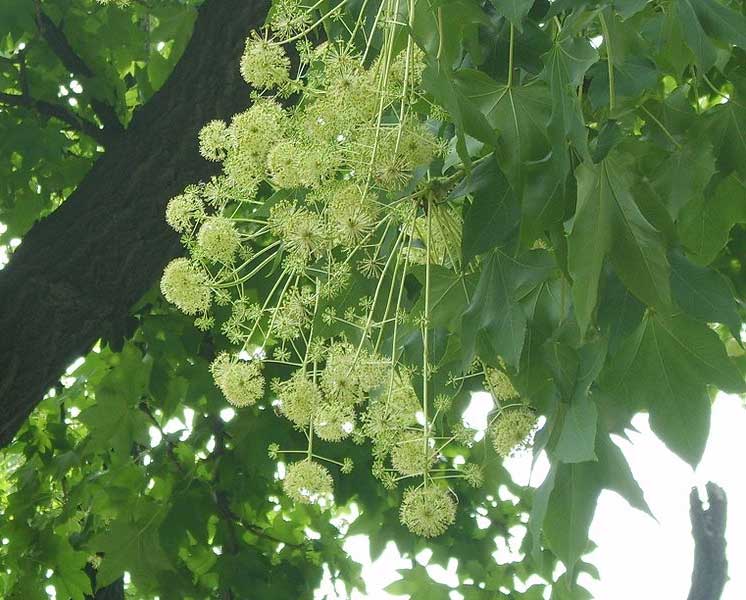
Kalopanax septemlobus (*)
Classification System: APG IV
Superregnum: Eukaryota
Regnum: Plantae
Cladus: Angiosperms
Cladus: Eudicots
Cladus: Core eudicots
Cladus: Asterids
Cladus: Campanulids
Ordo: Apiales
Familia: Araliaceae
Subfamilia: Aralioideae
Genus: Kalopanax
Species: K. septemlobus
Subspecies: K. s. subsp. lutchuensis – K. s. subsp. septemlobus
Forma: K. s. f. maximowiczii
Name
Kalopanax septemlobus (Thunb.) Koidz., Bot. Mag. (Tokyo) 39: 306. 1925.
Synonyms
Basionym
Acer septemlobum Thunb. in J.A.Murray, Syst. Nat. ed. 14: 912. 1784.
Homotypic
Acanthopanax septemlobus (Thunb.) Koidz. ex Rehder, Man. Cult. Trees: 859. 1927.
Heterotypic
Acanthopanax acerifolius Schelle, Mitt. Deutsch. Dendrol. Ges.: 217. 1908.
Acanthopanax ricinifolius (Siebold & Zucc.) Seem., J. Bot. 6: 140. 1868.
Acer pictum Thunb. Nova Acta Soc. Sc. Upsal. 4. 40. 1784-85, nom. illeg. non Thunb. ex Murray (1784).
Aralia maximowiczii Van Houtte, Fl. Serres Jard. Paris, II, 20: 39. 1874.
Brassaiopsis ricinifolia (Siebold & Zucc.) Seem., J. Bot. 2: 291. 1864.
Kalopanax autumnalis Koidz., Bot. Mag. (Tokyo) 37: 58. 1923.
Kalopanax pictus Nakai, Fl. syl. kor. 16:34, t. 8-10. 1927, based on the illegitime Acer pictum Thunb.
Kalopanax pictus f. maximowiczii (Van Houtte) H.Hara, Bot. Mag. (Tokyo) 50: 365. 1936.
Kalopanax pictus var. lutchuensis (Nakai) Nemoto, Fl. Jap. Suppl.: 528. 1936.
Kalopanax pictus var. magnificus (Zabel) Nakai, Fl. Sylv. Kor. 16: 36. 1927.
Kalopanax ricinifolius (Siebold & Zucc.) Miq., Ann. Mus. Bot. Lugduno-Batavi 1: 16. 1863.
Kalopanax ricinifolius var. lutchuensis Nakai, J. Arnold Arbor. 5: 13. 1924.
Kalopanax ricinifolius var. magnificus Zabel, Gartenwelt 11: 535. 1907.
Kalopanax septemlobus f. maximowiczii (Van Houtte) H.Ohashi, J. Jap. Bot. 69: 29. 1994.
Kalopanax septemlobus subsp. lutchuensis (Nakai) H.Ohashi, J. Jap. Bot. 69: 29. 1994.
Kalopanax septemlobus var. lutchuensis (Nakai) Ohwi, Fl. Jap., ed. rev.: 667. 1965.
Kalopanax septemlobus var. magnificus (Zabel) Hand.-Mazz., Symb. Sin. 7: 699. 1933.
Kalopanax septemlobus var. maximowiczii (Van Houtte) Hand.-Mazz., Symb. Sin. 7: 699. 1933.
Kalopanax septemlobus var. pilosus Q.Z.Yu, Acta Bot. Boreal.-Occid. Sin. 5: 234. 1985, no type indicated.
Panax ricinifolius Siebold & Zucc., Abh. Math.-Phys. Cl. Königl. Bayer. Akad. Wiss. 4(2): 199. 1843.
Tetrapanax ricinifolius (Siebold & Zucc.) K.Koch, Wochenschr. Gärtnerei Pflanzenk. 2: 371. 1859.
References
Chang, C. S. & al. 2003. A morphometric analysis of the eastern Asian Kalopanax septemlobus (Thunb.) Koidz. (Araliaceae). Bot. Bull. Acad. Sin. 44:337–344.
Govaerts, R. & al. 2006. World Checklist of selected plant families. The Board of Trustees of the Royal Botanic Gardens. 2009 Dec 21 [1]
Vernacular names
English: Prickly Castor Oil Tree
한국어: 음나무
Kalopanax septemlobus, common names castor aralia, tree aralia,[1] and prickly castor oil tree,[2] is a deciduous tree in the family Araliaceae, the sole species in the genus Kalopanax. It is native to northeastern Asia, from Sakhalin and Japan west to southwestern China. It is called cìqiū (刺楸) in Chinese, eumnamu (음나무) in Korean, and harigiri (ハリギリ; 針桐) in Japanese.[1]
Description
The tree grows to 30 metres (98 ft) tall, with a trunk up to 1–1.5 metres (3.3–4.9 ft) diameter. The stems are often spiny, with stout spines up to 1 centimetre (0.39 in) long. The leaves are alternate, in appearance similar to a large Fatsia or Liquidambar (sweetgum) leaf, 15–35 centimetres (5.9–13.8 in) across, palmately lobed with five or seven lobes, each lobe with a finely toothed margin.
The leaf lobes vary greatly in shape, from shallow lobes to cut nearly to the leaf base. Trees with deeply lobed leaves were formerly distinguished as K. septemlobus var. maximowiczii, but the variation is continuous and not correlated with geography, so it is no longer regarded as distinct.
The flowers are produced in late summer in large umbels 20–50 centimetres (7.9–19.7 in) across at the apex of a stem, each flower with 4–5 small white petals. The fruit is a small black drupe containing two seeds.
Cultivation and spread
The tree is cultivated as an ornamental tree for the "tropical" appearance of its large palmate leaves in Europe and North America; despite its tropical looks, it is very hardy, tolerating temperatures down to at least −40 °C (−40 °F). The plant grows very quickly at first, however slowing in growth rate when reaching around 40 years old.
The tree has been found growing wild in several US states, including New Hampshire, Connecticut, and Maryland. It is viewed with concern by the US National Park Service[3] and the Maryland Department of Natural Resources.[4]
Culinary use
In Korea, young shoots, called eumnamu-sun, are often eaten as sukhoe (blanched dish).
References
"Kalopanax septemlobus". Germplasm Resources Information Network (GRIN). Agricultural Research Service (ARS), United States Department of Agriculture (USDA).
Lee, Sangtae; Chang, Kae Sun, eds. (2015). English Names for Korean Native Plants (PDF). Pocheon: Korea National Arboretum. p. 506. ISBN 978-89-97450-98-5. Retrieved 7 March 2019 – via Korea Forest Service.
Annear, Steve (July 29, 2015). "Invasive tree taking root in N.H. may trace back to Harvard". Boston Globe. Retrieved 2015-08-03.
"Invader of the Month_September 2011". www.mdinvasivesp.org. Retrieved 20 May 2017.
Retrieved from "http://en.wikipedia.org/"
All text is available under the terms of the GNU Free Documentation License

